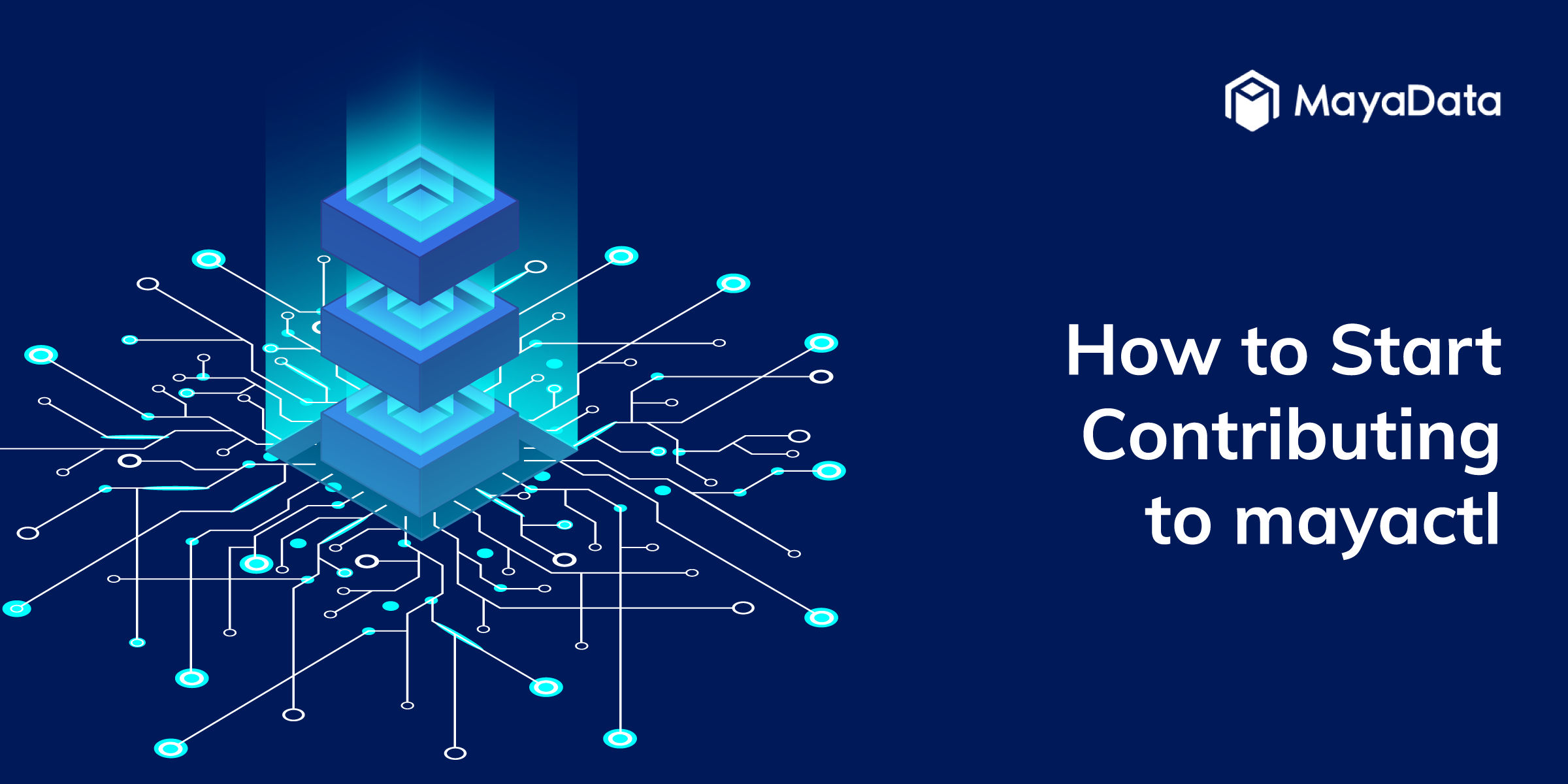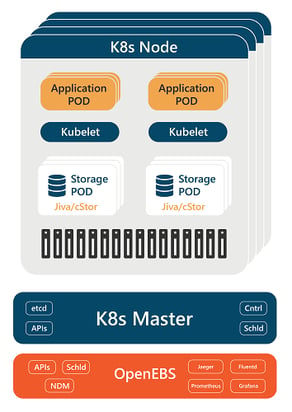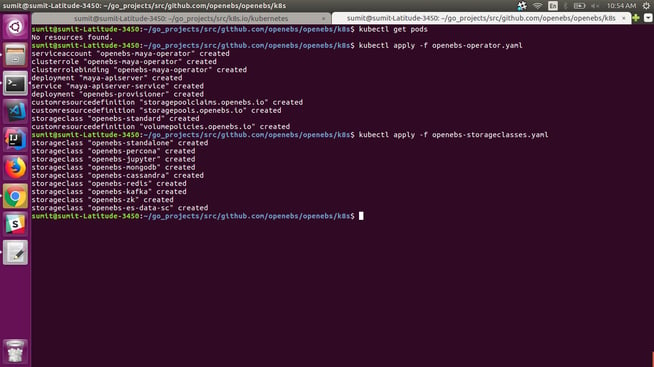What is mayactl?
- mayactl is the command line tool used for interacting with OpenEBS volumes. mayactl is not required while provisioning or managing the OpenEBS volumes, but it is currently used during debugging and troubleshooting.
- mayactl is the client, like kubectl, that submits requests to the maya-apiserver to obtain specific information, whereas kubectl submits requests to the Kubernetes apiserver to get specific information.
- mayactl helps retrieve storage-related information for debugging/troubleshooting storage-related issues. It provides various commands to create volume, view volume details, and create, list, and revert snapshots and much more.

To learn more about mayactl, visit mayactl·
Edit description: docs.openebs.io
OpenEBS Architecture

OpenEBS Architecture
To learn more about OpenEBS visit: https://docs.openebs.io/docs/next/introduction.html
These items must be installed in your system (with Ubuntu host) to run mayactl:
1. Docker: To install docker, run the commands shown below. You can also visit the official docker website to complete the installation.
sudo apt-get update
sudo apt-get install apt-transport-https ca-certificates curl software-properties-common
curl -fsSL https://download.docker.com/linux/ubuntu/gpg | sudo apt-key add -
sudo add-apt-repository \
"deb [arch=amd64] https://download.docker.com/linux/ubuntu \
$(lsb_release -cs) \
stable"
sudo apt-get update
sudo apt-get install docker.io- Or you can visit the official docker website to install docker
To get started with Docker CE on Ubuntu, make sure you meet these requirements, then install Docker. Prerequisites- docs.docker.com
2. open-iscsi package: To install the open-iscsi package, run these commands:
sudo apt-get update
sudo apt-get install open-iscsi
sudo service open-iscsi restart3. Golang: To install golang, visit the official golang website: https://golang.org/doc/install
4. Minikube: To install minikube, run these commands:
# minikube requires virtualbox to be installed as a dependency
sudo apt-get install virtualbox virtualbox-ext-pack
sudo apt-get update
# minikube version 0.24.0
curl -Lo minikube https://storage.googleapis.com/minikube/releases/v0.24.0/minikube-linux-amd64 && chmod +x minikube && sudo mv minikube /usr/local/bin/5. Kubectl: Run these commands to install Kubectl:
curl -LO https://storage.googleapis.com/kubernetes-release/release/v1.8.0/bin/linux/amd64/kubectl
chmod +x ./kubectl
sudo mv ./kubectl /usr/local/bin/kubectlHow do I run mayactl in a local machine for development purposes?
1. Open the openebs repo ( https://github.com/openebs/openebs) and star the openebs repo.. 😄 (Not Mandatory)
2. Fork the openebs/openebs and openebs/maya repositories into your GitHub account.
- Visit and click on the fork option (both repositories)
OpenEBS is containerized block storage written in Go for cloud native and other environments w/ per container (or pod)…github.com
maya — OpenEBS Maya extends Kubernetes capabilities to orchestrate CAS containers.github.com
3. Clone the openebs and maya repositories inside your gopath. Then run these commands to clone:
# if directories not present create the directories in same hierarchy
cd $GOPATH/src/github.com/openebs
git clone https://github.com/<your-github-username>/openebs.git
git clone https://github.com/<your-github-username>/maya.git4. Run the single node cluster using the minikube command.
minikube start --vm-driver=none
# To check whether minikube is configured and running
minikube status5. Install OpenEBS by executing these commands:
cd $GOPATH/src/github.com/openebs/openebs/k8s/
kubectl apply -f openebs-operator.yaml
kubectl apply -f openebs-storageclasses.yaml
6. Now we have the openebs-provisioner and maya-apiserver running as a pod in the Kubernetes (minikube) cluster.
- To get the pods, run this command:
kubectl get pods
NAME READY STATUS RESTARTS AGE
maya-apiserver-7b8d5496cc-kgmnn 1/1 Running 0 3m
openebs-provisioner-6797d44769-phnnc 1/1 Running 2 3m7. To run/access mayactl, you will need to login/execute into the maya-apiserver pod on Kubernetes.
- Find out the name of the maya api-server pod by running the following commands:
kubectl get pods
# It will access the bash shell inside the pod
kubectl exec -it <maya-apiserver-podname> /bin/bash8. Now you can run all mayactl commands as you are inside the maya-apiserver pod.
- Try running these commands after exececute/login into the pod.
mayactl -helpGo through the issues (https://github.com/openebs/maya/issues) and start modifying the mayactl code, located in $GOPATH/src/github.com/openebs/maya/cmd/mayactl, and start contributing to OpenEBS. Also, you can start contributing by writing a small unit test code in mayactl. For every PR you raise, you will also receive goodies from the OpenEBS team. 😃
How do I test the changes made in mayactl?
1. After modifying the mayactl code, go into the maya directory, i.e $GOPATH/src/github.com/openebs/maya, and run these commands:# run this if not currently in maya directory
cd $GOPATH/src/github.com/openebs/maya
# this will create the mayactl binary into the bin folder inside maya directory
make mayactl2. After the build has been completed, copy the mayactl binary from the bin folder to the maya-apiserver pod using the command:
kubectl cp $GOPATH/src/github.com/openebs/maya/bin/maya/mayactl <maya-apiserver-podname>:/tmp/3. Login/execute into the maya-apiserver pod to run the mayactl binary.
kubectl exec -it <maya-apiserver-podname> /bin/bash
cd /tmp/4. Here the mayactl binary you copied is shown.
- To run that binary, use the following command:
./mayactl -helpNow you can easily see the changes you made in the mayactl command line tool. You are also now ready to raise the PR’s. 😃
Reference:
This article was first published on Aug 15, 2018 on OpenEBS's Medium Account






Game changer in Container and Storage Paradigm- MayaData gets acquired by DataCore Software
Don Williams
Don Williams
Managing Ephemeral Storage on Kubernetes with OpenEBS
Kiran Mova
Kiran Mova
Understanding Persistent Volumes and PVCs in Kubernetes & OpenEBS
Murat Karslioglu
Murat Karslioglu